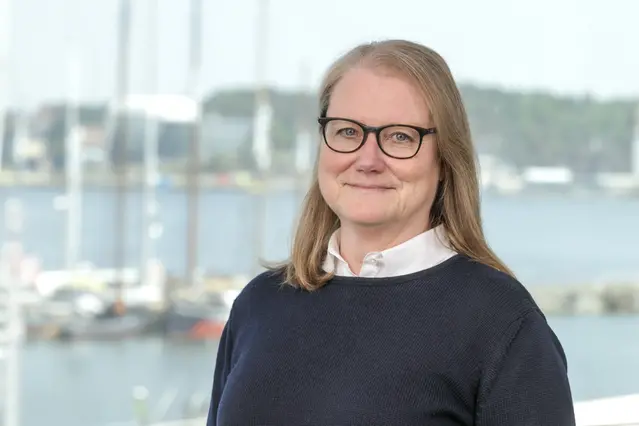Irene Wåhlström
Fil. dr i naturvetenskap, inriktning kemi.
Forskare vid SMHIs oceanografiska forskningsenhet.

Irene Wåhlström
Kontakt och CV
Publikationer
Verksamhetsområden
Jag arbetar framför allt med biogeokemisk modellering i Laptev havet och Östersjön med focus på karbonat systemet och metan.
Forskningsintressen
- Marin biogeokemi
- Kol
- Arktiska oceanen
Särskild kompetens
Nettoflödet av koldioxid och metan mellan hav och atmosfär.
Incorporating ecosystem component interactions and indirect effects in cumulative impact assessment models
Irene Wåhlstrom, Diana Perry, Sanne Bergman, Martin Dahl, Maria E. Granberg, Martin Gullstrom, Linus Hammar Perry, Kerstin Magnusson, Peter Thor
Sammanfattning
The cumulative impact of anthropogenic pressures on coastal seas is important to consider for a strategic and sustainable management of marine ecosystems. We aim to demonstrate how, and to what extent, incorporating interactions among ecosystem components (species and habitats) and indirect effects of pressures through other ecosystem components can develop existing cumulative impact assessment (CIA) models. A Swedish case study area was selected to test a simplified version of the extended regional Symphony CIA model. Five pollution- and climate-driven pressures acting on three trophically connected ecosystem components, i.e. cod, herring and plankton species/organism groups, were used. In addition, we conducted a systematic review of the scientific literature to determine the impact weight scores for an advancement of the method. The results from the development of CIA models clearly indicate the importance of introducing ecosystem component interactions and indirect effects into CIA models. The total cumulative impact increased by 117 % in the test area, but even more importantly, the development of the model resulted in a spatially more detailed outcome with a greater spatial variability in the magnitude of the total cumulative impact. New areas were highlighted that are under pressure compared to the original model. Thus, the development of the model captures cumulative impacts that would otherwise be overlooked if ecosystem component interactions and indirect effects were ignored. These types of changes to CIA models are required to increase the predictive power and ecological relevance to accommodate solid holistic and ecosystem-based marine management.
Relative importance of internal phosphorus sources in the Swedish coastal zone
Moa Edman, Irene Wåhlstrom, Simon Pliscovaz, Daniel Carlsson
I: RO, Rapport Oceanografi
2025
Sammanfattning
Several decades of remedial work have reduced the supply of nutrients from land to sea. Despite this, large-scale eutrophication remains a significant environmental problem along the Swedish coast and release of phosphorus from the sediments exacerbate the problem and reduces the effect of land load reductions. Thus, there is a need to identify where targeted remedial actions would have the most significance, and the highest likelihood to succeed. Additionally, there is a need to map the long-term relation between oxygen concentration and phosphate release from marine sediments in the Swedish coastal zone, which will support the aim to provide a scientific basis for prioritizing remedial targeted actions.
The results presented in this report indicate that there are more than 100 waterbodies along the Swedish coast with significant correlation between low oxygen concentrations and increased release of phosphorus from bottom sediments. However, oxygen concentrations below 1 ml L-1 is not the main driver for phosphorus release from Swedish coastal sediments and only three water bodies were found to actually have a net long-term internal source of phosphorus. The results also indicate that the number of years and autumns with an internal net release of phosphorus in the Swedish coastal zone seems to be decreasing, generally, and especially in late summer and autumn. An exception is the coastal zone bordering the northern Baltic Sea where, on an annual basis, the number of years and autumns with a net phosphorus outflux from the sediments seem to increase instead. Finally, it should be noted that locations with a significant correlation between low oxygen concentrations and increased release of phosphorus from bottom sediments do not necessarily overlap with areas with a generally high sediment phosphorus outflux. Thus, both types of areas need to be considered for targeted actions.
Colored Dissolved Organic Matter (CDOM), is the light absorbing fraction of the Dissolved Organic Matter (DOM) and is mainly of terrestrial origin. These substances are highly variable in the coastal zone and absorb and scatter light at different wavelengths and increase the light attenuation in the water column. As a consultation response from the latest Action Program for the Marine Environment an initial literature search of CDOM in Sweden's coastal waters and summary of the available literature and data was completed. It showed that the Swedish coastal observations of CDOM in the SHARKweb database are sparse and only locally occuring. However, the availiable litterature indicates that CDOM likely has a significant effect on the light attenuation in Swedish coastal waters. Future changes in light attenuation in the coastal zone are assumed to be driven largely by the changes in the terrestrial inputs. River discharge is expected to increase in a future climate, and thus also the supply of CDOM and nutrients to the coastal zone.
Increased nutrient retention and cyanobacterial blooms in a future coastal zone
Irene Wåhlstrom, Elin Almroth-Rosell, Moa Edman, Malin Olofsson, Kari Eilola, Vivi Fleming, Matthias Groger, Lars Arneborg, Markus Meier


